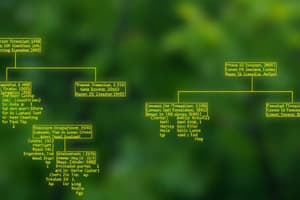Podcast
Questions and Answers
What does the entropy H(X) of a random variable X represent?
What does the entropy H(X) of a random variable X represent?
- The average length of all possible codes for X
- The maximum number of bits needed for any symbol
- The expected number of bits needed to encode a randomly drawn value of X (correct)
- The total probability of all outcomes for X
What encoding method was introduced by David Huffman in 1952?
What encoding method was introduced by David Huffman in 1952?
- Run-length encoding
- Huffman coding scheme (correct)
- Arithmetic coding
- Shannon-Fano coding technique
Which of the following statements accurately reflects the assignment of bits in coding according to information theory?
Which of the following statements accurately reflects the assignment of bits in coding according to information theory?
- Each symbol is assigned 1 bit regardless of its probability
- More probable symbols receive fewer bits than less probable symbols (correct)
- All symbols must have equal probabilities to be efficiently encoded
- Bits assigned are proportional to the square of the symbol's probability
What does the expression -log2P(X=i) calculate in information theory?
What does the expression -log2P(X=i) calculate in information theory?
Which of the following best describes the concept of entropy in the context of encoding?
Which of the following best describes the concept of entropy in the context of encoding?
What is represented by the function 'f' in the context of decision trees?
What is represented by the function 'f' in the context of decision trees?
Which set denotes the possible function hypotheses in decision trees?
Which set denotes the possible function hypotheses in decision trees?
What does the input 'TnD' consist of in the decision tree process?
What does the input 'TnD' consist of in the decision tree process?
In a decision tree, what is the primary output after processing the training data?
In a decision tree, what is the primary output after processing the training data?
Which symbol is used to denote the set of possible instances in decision trees?
Which symbol is used to denote the set of possible instances in decision trees?
When referring to labeled instances in decision trees, which notation is used?
When referring to labeled instances in decision trees, which notation is used?
What does the set 'E' represent in the context of decision trees?
What does the set 'E' represent in the context of decision trees?
Which of the following correctly reflects the relationship between the input and output in decision trees?
Which of the following correctly reflects the relationship between the input and output in decision trees?
What is the result of the calculation for $I(T)$?
What is the result of the calculation for $I(T)$?
What does the variable $I(Pat, T)$ represent in this context?
What does the variable $I(Pat, T)$ represent in this context?
What does the computation of $I(Type, T)$ equal?
What does the computation of $I(Type, T)$ equal?
What is the gain from patrons calculated as $Gain(Pat, T)$?
What is the gain from patrons calculated as $Gain(Pat, T)$?
How is $Gain(Type, T)$ determined?
How is $Gain(Type, T)$ determined?
What is the entropy computation $I(Pat, T)$ simplified expression involving logarithms?
What is the entropy computation $I(Pat, T)$ simplified expression involving logarithms?
Which value is essential in computing the information entropy for $I(T)$?
Which value is essential in computing the information entropy for $I(T)$?
In the context provided, what does the $Gain(Type, T)$ of 0 indicate?
In the context provided, what does the $Gain(Type, T)$ of 0 indicate?
What is the entropy of a group where all examples belong to the same class?
What is the entropy of a group where all examples belong to the same class?
What does the entropy equal for a group with 50% in either class?
What does the entropy equal for a group with 50% in either class?
What is the significance of low entropy in a training set?
What is the significance of low entropy in a training set?
Which of the following correctly describes the concept of information gain?
Which of the following correctly describes the concept of information gain?
Which attribute would be most useful for distinguishing between classes in a dataset according to information gain?
Which attribute would be most useful for distinguishing between classes in a dataset according to information gain?
How is entropy mathematically expressed for a given class x?
How is entropy mathematically expressed for a given class x?
Which statement is true regarding maximum entropy?
Which statement is true regarding maximum entropy?
What does a high level of impurity in a training set suggest?
What does a high level of impurity in a training set suggest?
How accurate was the decision tree in classifying examples for breast cancer diagnosis compared to human experts?
How accurate was the decision tree in classifying examples for breast cancer diagnosis compared to human experts?
What did the decision tree designed by British Petroleum replace?
What did the decision tree designed by British Petroleum replace?
Which type of data handling is NOT explicitly mentioned as a feature of C4.5?
Which type of data handling is NOT explicitly mentioned as a feature of C4.5?
What is one potential advantage of using decision trees over human experts in decision making?
What is one potential advantage of using decision trees over human experts in decision making?
In the context of the content provided, which method is used for experimental validation of performance?
In the context of the content provided, which method is used for experimental validation of performance?
How many attributes were used by Cessna in their airplane flight controller decision tree?
How many attributes were used by Cessna in their airplane flight controller decision tree?
What is one feature for handling noisy data in decision trees mentioned in the content?
What is one feature for handling noisy data in decision trees mentioned in the content?
Which of the following best describes the extension C4.5 in relation to ID3?
Which of the following best describes the extension C4.5 in relation to ID3?
Flashcards are hidden until you start studying
Study Notes
Decision Trees and Function Approximation
- Decision trees function as a model to approximate an unknown target function ( f: X \rightarrow Y ).
- Possible instances are represented by set ( X ) and possible labels by set ( Y ).
- A collection of function hypotheses to approximate ( f ) is denoted as ( H = { h | h: X \rightarrow Y } ).
- Input consists of training examples ( {(x_i, y_i)}_{i=1}^n ) for learning the target function.
Entropy in Information Theory
- Entropy ( H(X) ) measures the impurity of a random variable ( X ).
- It quantifies the average number of bits required to encode a value from ( X ) using optimal coding.
- Entropy is defined by the formula ( H(X) = -\sum_{i=1}^{n} P(x=i) \log_2 P(x=i) ).
- A group where all instances belong to the same class has ( H = 0 ) (minimum impurity), making it ineffective for training.
- A balanced group (50-50 distribution across classes) achieves maximum impurity with ( H = 1 ), ideal for training.
Sample Entropy and Information Gain
- Sample entropy is a specific instance of entropy based on available data.
- Information gain is a metric for determining the usefulness of attributes in classifying instances.
- Gain is calculated as the difference between prior entropy and conditional entropy after splitting on an attribute.
Huffman Coding
- In 1952, David Huffman introduced an optimal coding scheme that minimizes average code length.
- This scheme is particularly effective when symbol probabilities are powers of ( 1/2 ).
Applications and Performance of Decision Trees
- Decision trees are competitive with human experts in specific domains, such as medical diagnosis.
- A study found decision trees classified breast cancer cases correctly 72% of the time, compared to 65% for human experts.
- British Petroleum employed decision trees for gas-oil separation on offshore platforms, replacing earlier rule-based systems.
Extensions of ID3 Algorithm
- ID3 algorithm enhancements include handling real-valued and noisy data, pruning trees, and rule generation.
- C4.5 is a notable extension that allows for missing values, continuous attribute ranges, and better validation through cross-validation methods.
Practical Example of Information Gain Calculation
- For a set of training instances, calculations yield specific information gains for different attributes:
- ( I(Type, T) = 1 ) indicates full information retention through the attribute.
- Other attributes yield gains demonstrating less information retention and thus lesser efficacy in discrimination between classes.
Studying That Suits You
Use AI to generate personalized quizzes and flashcards to suit your learning preferences.




